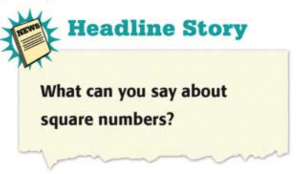Multiplication and Large Puzzles, #9
Grade 5
Introduction
After reading the question to the students, it may help to generate and write down a list of square numbers up as high as 20 X 20, so that students can look at them and “play” with them as they think about what they can say.
Headline Story
What can you say about square numbers?
Possible student responses
- Some examples are 1, 4, 9, and 16.
- They always have an odd number of factors.
- Squares of primes have only 3 factors: 1, the original prime, and its square.
- A square number of tiles can be put into a square array.
- The difference between any two neighboring squares is always odd.
- Square numbers end with 0, 1, 4, 9, 6, or 5, and never 2, 3, 7, or 8.
- The product of any two square numbers is also a square number (for example, 4 × 9 = 36, 4 × 16 = 64, and 9 × 25 = 225).
- The sum of two square numbers can be a square number, but isn’t always: 9 + 16 = 25 and 25 + 144 = 169, but 4 + 9 = 13.
- There are only nine square numbers less than 100.
- The difference between any two neighboring squares is always the sum of the numbers that were squared (for example: 26 – 16 = 5 + 4).
Note to Teachers: Student responses will likely be more simplistic.

This work is licensed under a
Creative Commons Attribution-NonCommercial-NoDerivatives 4.0 International License.

